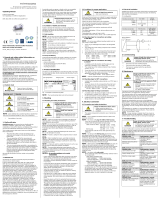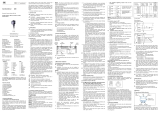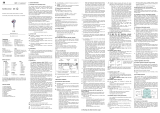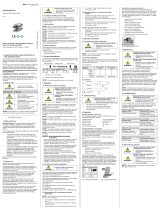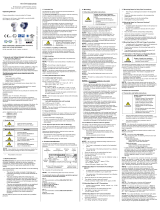
BD-Sensors-Str.1; 95199 Thierstein, Germany
Phone: +49 (0) 92 35 98 11 0 | www.bdsensors.de
© 2021 BD|SENSORS GmbH – All rights reserved
Operating manual
Precision pressure transmitters
xact ci und xact i
READ THOROUGHLY BEFORE USING THE DEVICE
KEEP FOR FUTURE REFERENCE
ID: BA_xact_E | Version: 01.2021.0
1. General and safety-related information on
this operating manual
This operating manual enables safe and proper handling of the
product, and forms part of the device. It should be kept in close
proximity to the place of use, accessible for staff members at
any time.
All persons entrusted with the mounting, installation, putting into
service, operation, maintenance, removal from service, and
disposal of the device must have read and understood the
operating manual and in particular the safety-related information.
Complementary to this operating manual the current data sheet
has to be adhered to.
Download this by accessing www.bdsensors.de or request it:
[email protected] | phone: +49 (0) 92 35 / 98 11 0
In addition, the applicable accident prevention regulations,
safety requirements, and country-specific installation standards
as well as the accepted engineering standards must be
observed.
1.1 Symbols used
Warning word
- Type and source of danger
- Measures to avoid the danger
Warning word Meaning
DANGER
- Imminent danger!
- Non-compliance will result in
death or serious injury.
WARNING
- Possible danger!
- Non-compliance may result in
death or serious injury.
CAUTION
- Hazardous situation!
- Non-compliance may result in
minor or moderate injury.
NOTE - draws attention to a possibly hazardous situation that
may result in property damage in case of non-compliance.
Precondition of an action
1.2 Staff qualification
Qualified persons are persons that are familiar with the
mounting, installation, putting into service, operation,
maintenance, removal from service, and disposal of the product
and have the appropriate qualification for their activity.
This includes persons that meet at least one of the following
three requirements:
- They know the safety concepts of metrology and
automation technology and are familiar therewith as
project staff.
- They are operating staff of the measuring and
automation systems and have been instructed in the
handling of the systems. They are familiar with the
operation of the devices and technologies described in
this documentation.
- They are commissioning specialists or are employed in
the service department and have completed training that
qualifies them for the repair of the system. In addition,
they are authorized to put into operation, to ground, and
to mark circuits and devices according to the safety
engineering standards.
All work with this product must be carried out by qualified
persons!
1.3 Intended use
The device is intended for converting the physical parameter of
pressure into an electric signal. It has to be used only for this
purpose, considering the following information.
The above listed pressure transmitters have, according to the
type, been developed for applications in overpressure and
vacuum as well as for absolute pressure measurement for food
industry, pharmacy and biotechnology. The pressure
transmitters are configurable via integrated display and
operating module. Optionally the device offers HART-
communication.
Devices with 3-A and / or EHEDG certified process connection
have been developed especially for applications in food and
pharmaceutical industry. The process connection is hygienic and
can be sterilized.
Permissible measuring and cleaning media are gases or liquids,
which are compatible with the media wetted parts of the device
(according to data sheet) and your system. This must be
ensured for the application.
The user must check whether the device is suited for the
selected use. In case of doubt, please contact our sales
department ([email protected], phone: +49 (0) 92 35 98 11 0).
BD|SENSORS assumes no liability for any wrong selection and
the consequences thereof!
The technical data listed in the current data sheet are engaging
and must absolutely be complied with. If the data sheet is not
available, please order or download it from our homepage:
http://www.bdsensors.de
1.4 Incorrect use
WARNING
Danger through incorrect use
- Only use the device in permissible
media and in accordance with its
intended use.
- Do not use the device as a ladder or
climbing aid.
- The device must not be altered or
modified in any way.
- BD|SENSORS is not liable for damage
caused by improper or incorrect use.
1.5 Limitation of liability and warranty
Failure to observe the instructions or technical regulations,
improper use and use not as intended, and alteration of or
damage to the device will result in the forfeiture of warranty
and liability claims.
1.6 Safe handling
NOTE - Do not use any force when installing the device to
prevent damage of the device and the plant!
NOTE - Treat the device with care both in the packed and
unpacked condition!
NOTE - Do not throw or drop the device!
NOTE - Excessive dust accumulation and complete coverage
with dust must be prevented!
NOTE - The device is state-of-the-art and is operationally
reliable. Residual hazards may originate from the device if it is
used or operated improperly.
1.7 Scope of delivery
Check that all parts listed in the scope of delivery are included
free of damage, and have been delivered according to your
purchase order:
- pressure transmitter
- for mech. connections to DIN 3852: O-ring (remounted)
- mounting instructions or operating manual
- for optional SIL2 version: safety data sheet
1.8 UL-approval (for devices with UL marking)
The UL approval was effected by applying the US standards,
which also conform to the applicable Canadian standards on
safety.
Observe the following points so that the device meets the
requirements of the UL approval:
- only indoor usage
- maximum operating voltage: according to data sheet
- The device must be operated via a supply with energy
limitation (acc. to UL 61010) or an NEC Class 2 energy
supply.
2. Product identification
The device can be identified by means of the manufacturing
label with order code. The most important data can be gathered
therefrom.
Fig. 1 Example of manufacturing label
NOTE - The manufacturing label must not be removed!
3. Mounting
3.1 Mounting and safety instructions
DANGER
Danger of death from airborne parts,
leaking fluid, electric shock
- Always mount the device in a
depressurized and de-energized
condition!
DANGER
Danger of death from improper
installation
- Installation must be performed only by
appropriately qualified persons who
have read and understood the
operating manual.
NOTE - Do not remove the packaging or protective caps of the
device until shortly before the mounting procedure, to exclude
any damage to the diaphragm and the threads! Protective caps
must be kept! Dispose of the packaging properly!
NOTE - If there is increased risk of damage to the device by
lightning strike or overvoltage, increased lightning protection
must additionally be provided!
NOTE - Treat any unprotected diaphragm with utmost care;
this can be damaged very easily.
NOTE - Provide a cooling line when using the device in steam
piping and clarify the material compatibility.
NOTE - The measuring point must be designed in such a way
that cavitation and pressure surges are avoided.
NOTE - When installing the device, avoid high mechanical
stresses on the pressure port! This will result in a shift of the
characteristic curve or to damage, in case of very small pressure
ranges and devices with a pressure connection/port made of
plastic.
NOTE - In hydraulic systems, arrange the device such that the
pressure port points upwards. (venting)
NOTE - If the device is installed with the pressure port pointing
upwards, ensure that no liquid drains off on the device. This
could result in humidity and dirt blocking the gauge reference in
the housing and could lead to malfunctions. If necessary, dust
and dirt must be removed from the edge of the screwed joint of
the electrical connection.
NOTE - The permissible tightening torque depends on the
conditions on site (material and geometry of the mounting point).
The specified tightening torques for the pressure transmitter
must not be exceeded!
NOTES – for mounting outdoors or in a moist
environment:
- Please note that your application does not show a dew point,
which causes condensation and can damage the pressure
transmitter. There are specially protected pressure
transmitters for these operating conditions. Please contact us
in such case.
- Connect the device electrically straightaway after mounting or
prevent moisture penetration, e.g. by a suitable protective
cap. (The ingress protection specified in the data sheet
applies to the connected device.)
- Select the mounting position such that splashed and
condensed water can drain off. Stationary liquid on sealing
surfaces must be excluded!
- If the device has a cable outlet, the outgoing cable must be
routed downwards. If the cable needs to be routed upwards,
this must be done in an initially downward curve.
- Mount the device such that it is protected from direct solar
radiation. In the most unfavourable case, direct solar radiation
leads to the exceeding of the permissible operating
temperature.
- A device with gauge reference in the housing (small hole next
to the electrical connection) must be mounted such that the
gauge reference is protected against dirt and humidity. If the
transducer is exposed to liquid admission, the gauge
reference will be blocked, and the equalization of air pressure
will be prevented. In this condition, a precise measurement is
impossible and damage to the transducer may occur.
3.2 Conditions for devices with 3-A symbol
and / or EHEDG certificate
The device or its connecting piece must be installed in such a
way that the surfaces are self-draining (permissible installation
position 273° … 87°).
Make sure that the welding socket is mounted flush inside the
tank.
The user is responsible for:
- the correct size of the seal and the choice of an
elastomeric sealing material that complies with the
3-A and / or EHEDG standard(s)
- an easy to clean installation position of the pressure
transmitter with little dead space, as well as definition /
verification / validation of a suitable cleaning process
- defining adequate service intervals
3.3 Mounting steps for connections according to
DIN 3852
NOTE -Do not use any additional sealing material such as tow,
hemp or Teflon tape!
The O-ring is undamaged and seated in the designated
groove.
The sealing face of the mating component has a flawless
surface. (RZ 3.2)
1 Screw the device into the corresponding thread by hand.
2 Devices equipped with a knurled ring:
only tighten by hand
3 Devices with a wrench flat must be tightened using a
suitable open-end wrench. Permissible tightening torques
for pressure transmitter:
- wrench flat made of steel:
G1/2": approx. 10 Nm
G1": approx. 20 Nm
G1 1/2": approx. 25 Nm
- wrench flat made of plastic: max. 3 Nm
3.4 Mounting steps for G1″ cone connection
1 Screw the device into the mating thread by hand (seal
produced metallically)
2 Then tighten it using an open-end wrench. Permissible
tightening torques for pressure transmitter:
pN < 10 bar: 30 Nm; pN ≥ 10 bar: 60 Nm
3.5 Mounting steps for dairy pipe connections
The O-ring is undamaged and seated in the designated
groove.
Chapter "3.2” has been noticed.
EHEDG conformity is only ensured in combination with
an approved seal. This is e.g.:
ASEPTO-STAR k-flex upgrade seal by Kieselmann GmbH
1 Centre the dairy pipe connection in the counterpart.
2 Screw the cup nut onto the mounting part.
3 Then tighten it using a hook wrench.
3.6 Mounting steps for Clamp and Varicent
connections
A suitable seal for the measured fluid and the pressure to
be measured is available.
Chapter "3.2” has been noticed.
EHEDG conformity is only ensured in combination with
an approved seal. This is e.g.:
for Clamp connections:
T-ring seal from Combifit International B.V.
for Varivent connections:
EPDM-O-ring which is FDA-listed
1 Place the seal onto the corresponding mounting part.
2 Centre the Clamp connection or Varivent connection
above the counterpart with seal.
3 Then fit the device with a suitable fastening element (e. g.
semi-ring or retractable ring clamp) according to the
supplier’s instructions.
3.7 Mounting steps for DRD and flange connections
A suitable seal for the measured fluid and the pressure to
be measured is available. (e.g. a fiber seal)
1 Put the seal between connecting flange and counter flange
2 Install the device with 4 resp. 8 screws (depending on
flange version) on the counter flange.
3.8 Orientation of the display and operating module
The display and operating module can be rotated continuously
so as to guarantee easy readability even in unusual mounting
positions. Proceed as follows to change the position:
- Unscrew the metal cap by hand.
- Rotate the display and operating module carefully by hand
into the desired position. The module is equipped with a
turning limiter.
- Before screwing on the cap again, the o-ring and sealing
surfaces of the housing have to be checked for damage and if
necessary, have to be changed!
- Afterwards screw the metal cap on by hand and make sure
that the housing is firmly locked again.
NOTE - Ensure that moisture cannot enter the device! The
seals and sealing surfaces must not get dirty, as (depending on
application and location) fouling can cause a reduced degree of
protection and therefore lead to device failure or irreparable
damage to the device.
4. Electrical connection
4.1 Connection and safety instructions
DANGER
Danger of death from electric shock
- Always mount the device in a
depressurized and de-energized
condition!
The supply corresponds to protection class III
(protective insulation).
NOTE - For the electrical connection a shielded and twisted
multicore cable is recommended.
NOTE - for devices with cable outlet
- When routing the cable, following bending radiuses have to
be complied with:
cable without ventilation tube:
static installation: 8-fold cable diameter
dynamic application: 12-fold cable diameter
cable with ventilation tube:
static installation: 10-fold cable diameter
dynamic application: 20-fold cable diameter
- In case of devices with cable outlet and integrated
ventilation tube, the PTFE filter located at the cable end on
the ventilation tube must neither be damaged nor removed!
Route the end of the cable into an area or suitable
connection box which is as dry as possible and free from
aggressive gases, in order to prevent any damage.
NOTE - If a transition is desired from a transmitter cable with
gauge tube to a cable without gauge tube, we recommend our
terminal box KL 1 or KL 2.
4.2 Electrical installation
Establish the electrical connection of the device according to the
technical data shown on the manufacturing label, the following
table and the wiring diagram.
Pin configuration
Electrical
connections M12x1 (4-pin) cable colours
(IEC 60757)
Supply +
Supply –
1
3
WH (white)
BN (brown)
Shield plug housing GNYE (green-yellow)
Wiring diagrams
2-wire system (current)
2-wire system (current) HART®
5. HART communication (optionally)
An additional signal as per HART specification is superimposed
on the analogue output signal. The device may be configured by
means of a HART communication device. In this regard, we
recommend the CIS 150 programming kit (available as
accessory).
In order to ensure trouble-free operation, the following
requirements must be taken into account:
Maximum cable length between measuring device and supply:
VVV CCR
L36
max
10401065
Wherein Lmax: maximum length of cable in [m]
R
V: resistance of cable together with load
resistance in []
C
V: capacity of cable in [pF/m]
Resistance R:
024,0
12U
R
wherein U: supply in [VDC]
The resistance must be at least 240 .
6. Commissioning
DANGER
Danger of death from airborne parts,
leaking fluid, electric shock
- Operate the device only within the
specification! (according to data sheet)
The device has been installed properly
The device does not have any visible defect
The device is operated within the specification.
(see data sheet)
7. Operation
7.1 Display and operating module
Fig. 2 Touch pad
A bar graph is shown in the display, which indicates the applied
pressure as a percentage of the measuring range. The display
of the measured value and the configuration of the individual
parameters is performed through the menu, via the display. The
individual functions can be set by means of three buttons
arranged under the cap.
The menu system is a closed system allowing you to scroll both
forward and backward through the individual set-up menus to
navigate to the desired setting item. All settings are permanently
stored in a Flash EPROM and therefore available again even
after disconnecting from the supply voltage.
Button functions
▲-button
move forward in the menu system
(beginning with menu 1)
increase the displayed value
▼-button
move backwards in the menu system
(beginning with the last menu)
decrease the displayed value
OK-button confirm the menu items and set values
Type designation Ordering code Serial number
OK-button
Bargraph
▼-button ▲-button
Display
x|act i:
74-07
p Supply +
Supply –
VS
I
Supply + / in +
Supply – / in -
VS
A
p
I

7.4 Configuration
If a parameter is configurable by a value, each digit may be
configured separately. That means after activating such a menu
item (e. g. "2.3.1 OFFSET") by pushing the OK-button, the first
digit of the currently set value will start to blink. Now scroll up or
down to the desired digit via the ▼- or ▲-button and confirm it
with the OK-button. After that, the next digit will start to blink.
Configure it in the same way. In the menu items "2.3.1
OFFSET" and "2.3.2 FINALVAL", the decimal point will then
start to blink, and it is also possible to change its position by
using the ▼- or ▲-button. By confirming the position with the
OK-button, the total value will be stored if permissible. If the
value is out of range, an error message (e. g. Error 03) will
appear in the display and the set value will not be stored. If you
intend to set a negative value, the first digit has to be configured
with the ▼-button.
To configurate the device, unscrew the metal cap by hand.
NOTE - Ensure that moisture cannot enter the device! The
seals and sealing surfaces must not get dirty, as (depending on
application and location) fouling can cause a reduced degree of
protection and therefore lead to device failure or irreparable
damage to the device.
NOTE - Before screwing on the cap again, the o-ring and
sealing surfaces of the housing have to be checked for damage
and if necessary, have to be changed! Afterwards screw the
metal cap on by hand and make sure that the housing is firmly
locked again.
execution of configuration:
- to enter the operating mode, push the ▲- or ▼-button
- set the desired menu item by pushing the ▲- or ▼-button
- activate the set menu item by pushing the OK-button
- set the desired value or select one of the offered settings by
using the ▲- or ▼-button
- store / confirm the set value / selected setting and exit the
menu by pushing the OK-button
8. Maintenance
DANGER
Danger of death from airborne parts,
leaking fluids, electric shock
- Always service the device in a
depressurized and de-energized
condition!
WARNING
Danger of injury from aggressive fluids
or pollutants
- Depending on the measured medium,
this may constitute a danger to the
operator.
- Wear suitable protective clothing
e.g. gloves, safety goggles.
If necessary, clean the housing of the device using a
moist cloth and a non-aggressive cleaning solution.
During the cleaning processes, note the compatibility of the
cleaning media used in combination with the media-wetted
materials of the pressure measuring devices. Permissible
concentrations and temperatures must be observed.
Verification/ validation by the user is essential.
Deposits or contamination may occur on the diaphragm/
pressure port in case of certain media. Depending on kind and
quality of the process, suitable cyclical maintenance intervals
must be specified by the operator. As part of this, regular checks
must be carried out regarding corrosion, damage of
diaphragm/seal(s) and signal shift. A periodical replacement of
the seal(s) may be necessary.
If the diaphragm is calcified, it is recommended to send the
device to BD|SENSORS for decalcification. Please note the
chapter ″Service / repair″ below.
NOTE - Wrong cleaning or improper touch may cause an
irreparable damage on the diaphragm. Therefore, never use
pointed objects or pressured air for cleaning the diaphragm.
9. Troubleshooting
In case of malfunction, it must be checked whether the device
has been correctly installed mechanically and electrically. Use
the following table to analyse the cause and resolve the
malfunction, if possible.
DANGER
Danger of death from airborne parts,
leaking fluids, electric shock
- If malfunctions cannot be resolved, put
the device out of service (proceed
according to chapter 10 up to 12)
9.1 Error messages
PASSED PARAMETER
TOO SMALL
entered parameter value is too
small
PASSED PARAMETER
TOO LARGE
entered parameter value is too
large
LOOP CURRENT NOT
ACTIVE
loop current is not active
(HART ID > 0, device works in
Multidrop mode)
APPLIED PROCESS TOO
LOW applied process is too low
APPLIED PROCESS TOO
HIGH applied process is too high
LOWER RANGE VALUE
TOO HIGH
lower range value (OFFSET) is
too high
LOWER RANGE VALUE
TOO LOW
lower range value (OFFSET) is
too low
UPPER RANGE VALUE
TOO HIGH
upper range value (FINALVAL)
is too high
UPPER RANGE VALUE
TOO LOW
upper range value (FINALVAL)
is too low
SPAN TOO SMALL span too small
DEVICE MALFUNCT
internal failure please send
the device to BD|SENSORS for
repair
9.2 Further errors and possible corrections
Fault: display does not work
Possible cause Fault detection / remedy
Connected incorrectly inspect the connections
Line break inspect all connecting lines
Defective energy supply
inspect the power supply and the
applied supply voltage at the
transmitter
Fault: no output signal
Possible cause Fault detection / remedy
Connected incorrectly inspect the connection
Line break
inspect all line connections
necessary to supply the device
(including the connector plugs)
Defective amperemeter
(signal input)
inspect the amperemeter (fine-
wire fuse) or the analogue input
of the PLC
Fault: analogue output signal too low
Possible cause Fault detection / remedy
Load resistance too high verify the value of the load
resistance
Supply voltage too low verify the output voltage of the
power supply
Defective energy supply
inspect the power supply and the
applied supply voltage at the
device
Fault: small shift of the output signal
Possible cause Fault detection / remedy
Diaphragm is highly polluted,
calcified or coated with
deposit
checking of diaphragm;
if necessary, send the device to
BD|SENSORS for repair
Fault: large shift of the output signal
Possible cause Fault detection / remedy
Diaphragm of sensor is
damaged (caused by
overpressure or
mechanically)
checking of diaphragm; when
damaged, send the device to
BD|SENSORS for repair
Fault: measured value (display and analogue output) deviates
from the nominal value
Possible cause Fault detection / remedy
High pressure / pressure
peaks recalibration or replacement of the
pressure port by BD|SENSORS is
required
Mechanical damage to
diaphragm
Fault: constant output signal at 4 mA
Possible cause Fault detection / remedy
Wrong ID number make sure that the set value
under menu item "ID" is "0000"
10. Removal from service
DANGER
Danger of death from airborne parts,
leaking fluids, electric shock
- Disassemble the device in a
depressurized and de-energized
condition!
WARNING
Danger of injury from aggressive
media or pollutants
- Depending on the measured medium,
this may constitute a danger to the
operator.
- Wear suitable protective clothing
e.g. gloves, goggles.
NOTE – After dismounting, mechanical connections must be
fitted with protective caps.
11. Service / repair
Information on service / repair:
- www.bdsensors.de
- Service phone: +49 (0) 92 35 98 11 0
11.1 Recalibration
The offset value or range value may shift during the life of the
device. In this case, a deviating signal value in relation to the set
lower or upper measuring range value is output. If one of these
two phenomena occur after extended use, a recalibration in the
factory is recommended. Please note the chapter
"Service/Repair" about this.
11.2 Return
WARNING
Danger of injury from aggressive
media or pollutants
- Depending on the measured medium,
this may constitute a danger to the
operator.
- Wear suitable protective clothing
e.g. gloves, goggles.
For every return shipment, whether for recalibration,
decalcification, alteration or repair, the device must be cleaned
thoroughly and packed in a break-proof manner. A return
declaration with a detailed fault description must be added to the
defective device. If your device has come into contact with
pollutants, a declaration of decontamination is additionally
required. Appropriate templates can be found on our homepage.
Download these by accessing www.bdsensors.de
or request them by e-mail or phone:
[email protected] | phone: +49 (0) 92 35 98 11 0
In case of doubt regarding the fluid used, devices without a
declaration of decontamination will only be examined after
receipt of an appropriate declaration.
12. Disposal
WARNING
Danger of injury from aggressive
media or pollutants
- Depending on the measured medium,
this may constitute a danger to the
operator.
- Wear suitable protective clothing
e.g. gloves, goggles.
The device must be disposed of according to the
European Directive 2012/19/EU (waste electrical
and electronic equipment). Waste equipment must
not be disposed of in household waste!
NOTE – Dispose of the device properly!
13. Warranty terms
The warranty terms are subject to the legal warranty period of
24 months, valid from the date of delivery. If the device is used
improperly, modified or damaged, we will rule out any warranty
claim. A damaged diaphragm will not be accepted as a warranty
case. Likewise, there shall be no entitlement to services or parts
provided under warranty if the defects have arisen due to normal
wear and tear.
14. Declaration of conformity / CE
The delivered device fulfils all legal requirements. The applied
directives, harmonised standards and documents are listed in
the EU declaration of conformity, which is available online at:
http://www.bdsensors.de.
Additionally, the operational safety is confirmed by the CE sign
on the manufacturing label.
7.2 Structure of the menu system
7.3 Menu list
1 DIPLAY Displa
y
paramete
r
1.1 Pmax Maximum pressure display (high pressure)
The maximum pressure that occurred durin
g
the measurement is shown on the displa
y
.
1.2 Pmin Minimum pressure display (low pressure)
The minimum pressure that occurred durin
g
the measurement is shown on the displa
y
.
1.3 Tmax Maximum temperature display (high temperature)
The maximum temperature that occurred durin
g
the measurement is shown on the displa
y
.
1.4 Tmin Minimum temperature display (low temperature)
The minimum temperature that occurred durin
g
the measurement is shown on the displa
y
.
1.5 CLEA
R
Delete the values 1.1-1.4
(
Pmax, Pmin, Tmax, Tmin
)
1.6 INFO Configuration of the display
Assignment of the settable digits
"1": 1st line: measured pressure 2nd set pressure unit
"2": 1st line: output signal 2nd line: mA
"3": 1st line: measured temperature 2nd line: °C
"4": 1st line: measured pressure 2nd line: change between pressure unit / output signal in mA
"5": 1st line: measured pressure 2nd line: change between pressure unit / temperature in °C"
"6": 1st line: measured pressure 2nd line:
c
han
g
e between pressure unit / output si
g
nal in mA / temperature in °C
1.7 RETURN Return to menu 1 DISPLAY
2 CALIB Confi
g
uration of measurin
g
ran
g
e, displa
y
and output si
g
nal
2.1 ZERO Zeroing the display
The message “CONFIRM” appears on the display when selecting the subsidiary menu item with the OK button. By holding the
OK button pressed for at least 2 seconds the zeroin
g
is performed, and the messa
g
e “CONFIRM” disappears from the displa
y
.
2.2 CAL REF Ad
j
usts the analo
g
ue output with pressure reference
2.2.1 OFFSET Adjusts the starting value for the output signal
After the reference pressure has been applied and accepted, selecting the subsidiary menu item with the OK button causes
the message "CONFIRM" to appear on the display. By holding the OK button pressed for at least 2 seconds the applied
pressure is specified as the starting value for the output signal (4 mA), and the message "CONFIRM" disappears from the
displa
y
. The displa
y
ed value remains unchan
g
ed.
2.2.2 FINALVAL Adjusts the end value for the output signal
After the reference pressure has been applied and accepted, selecting the subsidiary menu item with the OK button causes
the message "CONFIRM" to appear on the display. By holding the OK button pressed for at least 2 seconds the applied
pressure is specified as the end value for the output signal (20 mA), and the message "CONFIRM" disappears from the
displa
y
. The displa
y
ed value remains unchan
g
ed.
2.2.3 RETURN Return to menu 2.2 CAL REF
2.3 ADJUST Sets the measurin
g
ran
g
e and the zero point
2.3.1 OFFSET Sets the starting value of the measuring range
The ▲ and ▼ buttons allow you to define a starting value for the measuring range. The permitted input range is between 0 …
90% of the ori
g
inal measurin
g
ran
g
e
(
turn down max. 1:10
)
. 4 mA is output when the value that has been entered is reached.
2.3.2 FINALVAL Sets the end value of the measuring range
The ▲ and ▼ buttons allow you to define an end value for the measuring range. The permitted input range is between 10 …
100% of the original measuring range (turn down max. 1:10). 20 mA is output when the value that has been entered is
reached.
2.3.3 Z-CORR Zero-point correction of the display and output signal
The message "CONFIRM" appears on the display when selecting the subsidiary menu item with the OK button. By holding the
OK button pressed for at least 2 seconds the applied pressure is specified as the starting value for the output signal (4 mA),
and the displa
y
is zeroed. The messa
g
e "CONFIRM" disappears from the displa
y
.
2.3.4 RETURN Return to menu 2.2 CAL REF
2.4 RETURN Return to menu 2 CALIB
3 SIGNAL Si
g
nal parameters
3.1 FUNKTION Function selection
"Linear"
"2SQR" √
"2SQR3POW" √ cut off 2 %
"2SQR5POW" √
3.2 DENSITY Input of the density
settable ran
g
e: 100 … 9999 k
g
/m3;
c
onversion is onl
y
applicable to the units [mFH], [cmFH] and [mmFH]
3.3 DAMP Configuration of the damping
settable ran
g
e: 0 … 100 s
3.4 SIMULAT Simulation of the output signal
settable ran
g
e: an
y
, for example: 3.7 ... 22 mA
3.5 RETURN Return to menu 3 SIGNAL
4 SETTINGS Basic settin
g
s
4.1 DISPLAY Confi
g
uration of the displa
y
unit
4.1.1 UNIT P Configuration of the unit for pressure
units: bar, mbar, g/cm², kg/cm², Pa, kPa, Torr, atm, mH2O, ftH2O, MPa, mFH*, cmFH*, mmFH*, mmH2O, mmHg, psi
The conversion of all pressure-related parameters is performed automaticall
y
. *Input of the densit
y
is required.
(
see 3.2
)
4.1.2 UNIT T Configuration of the unit for temperature
units: °C and °F
4.1.3 RETURN Return to menu 4.1 DISPLAY
4.2 HART-ID HART-ID (only to be set with HART
®
devices in multi-drop mode)
Set the desired ID no. (between "0" and "15") and confirm this with the OK button. It is only necessary to configure this number
if you want to operate the device in multi-drop mode (connection of a number of HART® devices). If the ID no. is set to "0", the
multi-drop mode is deactivated, and the device operates in analo
g
ue mode.
4.3 USER-L Configuration of the user's security level
For security reasons it is necessary to enter the password before configuring the security level. Confirm this with the OK
button. The password is factory-set to "0000".
Security levels:
"0": the whole menu system is enabled
"1": the following menu items are enabled: 1 Display, 3 Signal, 4.3 USER-L
"2": the followin
g
menu items are enabled: 1 Displa
y
, 4.3 USER-L
4.4 PASSWORD Configuration of the password
For security reasons it is necessary to enter the previous password before configuration. Confirm this with the OK button. The
password is factory-set to "0000". Then set the new password and confirm this with the OK button.
If you have forgotten your password, you can request the master password, which is fixed at manufacture, from
BD
|
SENSORS.
4.5 LANGUAGE Selection of DE
(
German
)
or EN
(
En
g
lish
)
as the user lan
g
ua
g
e
4.6 WPROTECT Write protection (HART
®
-configuration)
"YES": write protection is activated, transmission of the HART® commands to the storage location is not possible
"NO": write protection is deactivated
4.7 RETURN Return to menu 4 SETTINGS
5 SERVICE Service
5.1 FACTORY Reset to factor
y
settin
g
s
5.2 ERR CURR Definition of the current
settable values: 21.6 mA or 3.8 mA; the selected error current is output in response to a malfunction in the electronics
5.3 TYPE Displa
y
of the device t
y
pe
5.4 SER-NO Displa
y
of the set serial numbe
r
5.5 VERS Displa
y
of the pro
g
ram version
(
firmware
)
5.6 RETURN Return to menu 5 SERVICE
6 RETURN Return to displa
y
mode
-
 1
1
-
 2
2
Simex x|act i Owner's manual
- Type
- Owner's manual
- This manual is also suitable for
Ask a question and I''ll find the answer in the document
Finding information in a document is now easier with AI
Related papers
Other documents
-
IFM TY9307 Installation guide
-
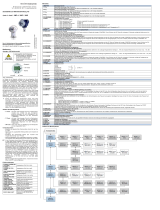 BD|SENSORS x|act ci Operating instructions
BD|SENSORS x|act ci Operating instructions
-
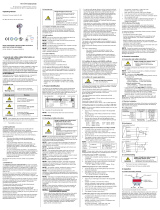 BD|SENSORS DS 400 Operating instructions
BD|SENSORS DS 400 Operating instructions
-
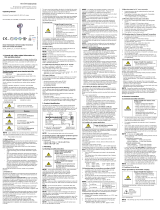 BD|SENSORS DS 400 Operating instructions
BD|SENSORS DS 400 Operating instructions
-
BD|SENSORS DS 200 Operating instructions
-
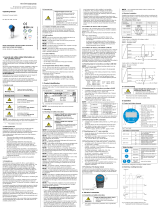 BD|SENSORS DS 350P Operating instructions
BD|SENSORS DS 350P Operating instructions
-
IFM PC5104 Operating instructions
-
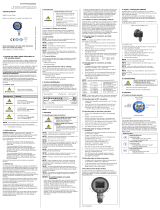 BD|SENSORS BAROLI 02 Operating instructions
BD|SENSORS BAROLI 02 Operating instructions
-
IFM PC5112 Operating instructions
-
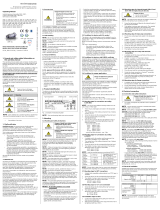 BD|SENSORS 18.605 G Operating instructions
BD|SENSORS 18.605 G Operating instructions


